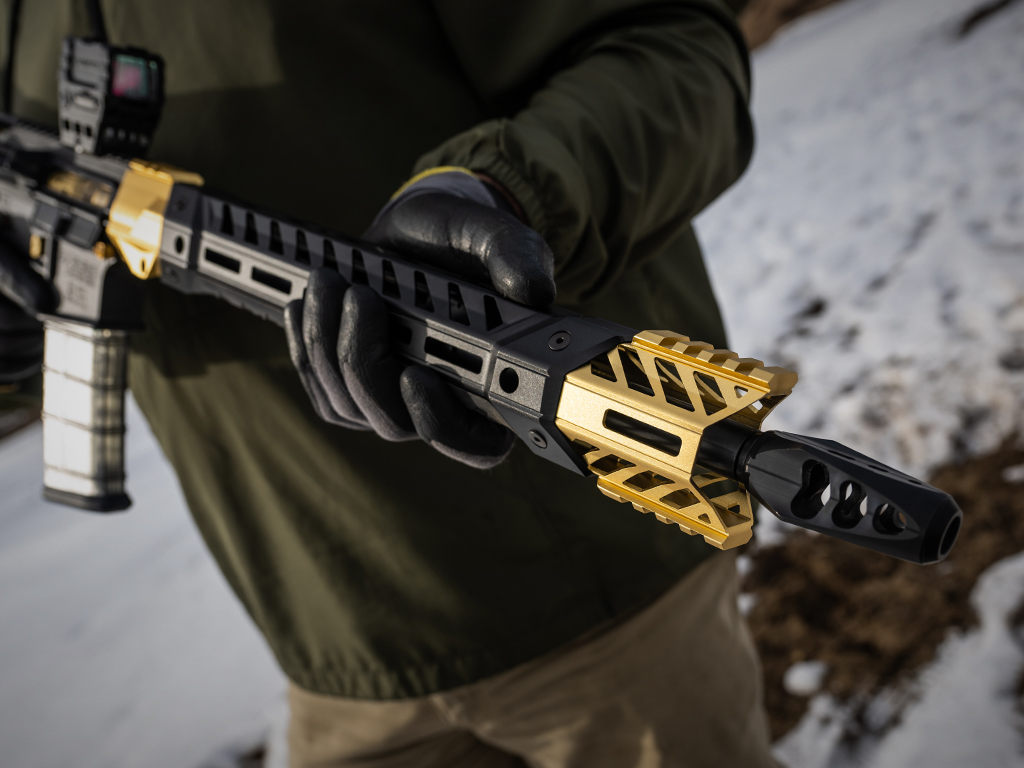Blog # 278 - Evolution of AR-15 Handguards and Rails: Where Style Meets Functionality

Dec 6, 2023
By Luke Cuenco
0 comment(s)
The AR-15, a rifle renowned for its adaptability and versatility, has undergone a captivating metamorphosis in its handguard and rail systems since its inception. From the humble origins of fixed, rudimentary handguards of the original AR-15 design to the contemporary marvels of modular, sleek designs, the evolution of these components epitomizes a saga where function intertwines with aesthetics. This journey isn’t merely about practical improvements but also about the fusion of style and performance, transforming the AR-15 into a canvas that shooters can customize not just for function but for individualized flair. Delving into this timeline reveals how these once-basic components have transcended their utilitarian roots to become integral facets of the AR-15's identity, mirroring the ever-changing needs and preferences of shooters across different realms of use.
Basic Beginnings
At the outset, AR-15 handguards served a functional purpose, providing heat protection without much concern for aesthetics. However, the introduction of Picatinny rails injected a sense of modularity and adaptability, transforming the rifle's appearance by allowing shooters to customize their firearms with various attachments. Free-floating handguards not only enhanced precision and heat dissipation but also introduced a sleeker look. The transition from fixed to free-floating designs not only boosted functionality but also contributed to the rifle's overall aesthetic appeal, giving it a more streamlined and modern appearance.
Modularity brought about a shift in style. KeyMod and M-LOK systems not only streamlined the profile of the handguards but also offered a more futuristic and minimalistic aesthetic. Shooters could now maintain a clean and uncluttered look while still having the capability to attach necessary accessories. The evolution of materials allowed for a blend of strength and elegance in handguard design. The incorporation of aluminum alloys, carbon fiber, and polymer composites not only reduced weight but also added a touch of sophistication to the rifle's appearance, striking a balance between ruggedness and refinement.
In the long run, it seems that KeyMod lost the popularity battle with M-LOK more or less becoming the modern standard for virtually all new AR-15 rifles featuring aluminum handguards. Even specific firearms using exotic handguard materials like carbon fiber often make use of the licensed M-LOK attachment design language. However, Picatinny, M-LOK, and even a few other antiquated or phased-out rail and handguard attachment designs can still be found out in the wild.
The Materials Science Behind Handguards
The evolution of materials in AR-15 handguards began with basic wood or polymer constructions, initially prioritizing function over weight or advanced performance. However, advancements brought about a materials revolution. Aluminum alloys debuted, balancing strength and reduced weight, enhancing durability without compromising handling or overall weight factor by too much. Actually, many modern aluminum handguards weigh either less or the same as some original plastic handguards.
The introduction of carbon fiber reshaped the landscape, offering exceptional strength with minimal weight, allowing for sleeker, more ergonomic designs while maintaining structural integrity. Polymer composites also gained ground, providing a mix of affordability, strength, and design flexibility, expanding options for personalized rifle setups. However, advanced materials like carbon fiber don’t hold up well in all scenarios and are often way more expensive than even some of the fanciest aluminum handguards.
Further innovation saw the occasional use of titanium, known for its impressive strength-to-weight ratio, in high-end handguards. Emerging manufacturing techniques like 3D printing hinted at a future of unparalleled customization and intricate designs, showcasing an ongoing pursuit for the perfect blend of strength, durability, and aesthetics in AR-15 components. Once again, cost is the limiting factor here since titanium is a highly expensive base material to not only purchase but is magnitudes more time-consuming and complex to machine meaning the final product often sells for an exorbitantly high price.
Ergonomics Takes Center Stage
While enhancing functionality, the emphasis on ergonomics also contributed to the rifle's overall style. Contoured designs, improved grip surfaces, and customizable lengths not only improved handling but also added a sense of fluidity and finesse to the rifle's aesthetics. The shift to shorter, more maneuverable handguards wasn't just about practicality; it also affected the rifle's aesthetics positively. Slim-profile handguards added a sense of agility to the rifle's appearance, giving it a more dynamic and purposeful look without compromising on accessory mounting options.
Specialized handguards designed for specific shooting environments didn’t just meet functional needs but also reflected a shooter's style preference. Heat-shielded slim variants for competition shooters and lightweight, low-profile designs for hunters conveyed a sense of purpose while maintaining a distinct style.
Future Horizons: Stylish Innovations on the Horizon
As the evolution of AR-15 handguards and rails continues, style and aesthetics will likely play a more significant role. Anticipated advancements, such as further weight reduction and innovative manufacturing techniques, are poised to introduce sleeker, more sophisticated designs, merging style seamlessly with functionality.
The Fusion of Style and Performance in AR-15 Evolution
The evolution of handguards and rails hasn’t just been about improving functionality; it’s been a journey of style evolution. From the utilitarian beginnings to the sleek and purpose-driven designs of today, the AR-15 platform's aesthetics have evolved hand-in-hand with its functionality, promising a future where style and performance go hand in hand.
